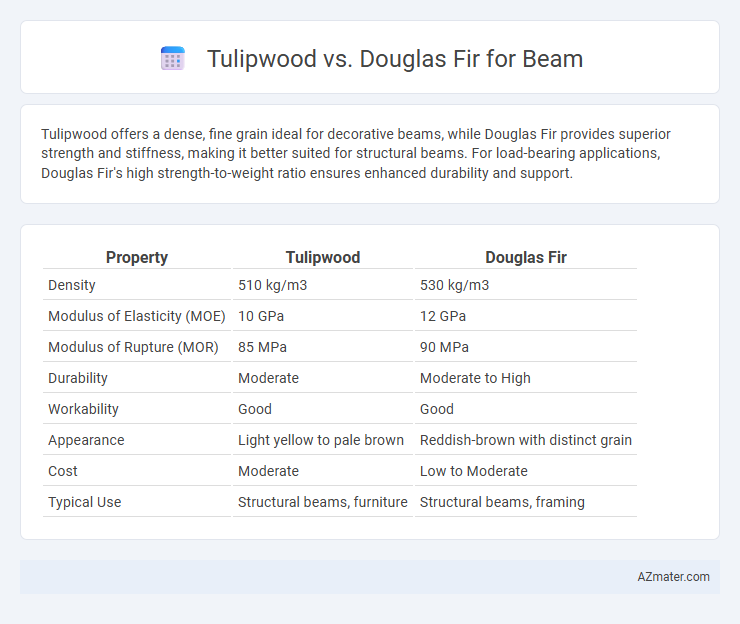Tulipwood offers a dense, fine grain ideal for decorative beams, while Douglas Fir provides superior strength and stiffness, making it better suited for structural beams. For load-bearing applications, Douglas Fir's high strength-to-weight ratio ensures enhanced durability and support.
Table of Comparison
| Property | Tulipwood | Douglas Fir |
|---|---|---|
| Density | 510 kg/m3 | 530 kg/m3 |
| Modulus of Elasticity (MOE) | 10 GPa | 12 GPa |
| Modulus of Rupture (MOR) | 85 MPa | 90 MPa |
| Durability | Moderate | Moderate to High |
| Workability | Good | Good |
| Appearance | Light yellow to pale brown | Reddish-brown with distinct grain |
| Cost | Moderate | Low to Moderate |
| Typical Use | Structural beams, furniture | Structural beams, framing |
Introduction to Tulipwood and Douglas Fir Beams
Tulipwood beams, derived from Liriodendron tulipifera, offer a lightweight yet strong option with a fine, straight grain and smooth texture, making them ideal for detailed woodworking and interior applications. Douglas Fir beams, sourced from Pseudotsuga menziesii, are renowned for their exceptional strength, durability, and resistance to warping, frequently used in heavy structural framing and outdoor projects. Both woods present advantages: Tulipwood excels in appearance and workability, while Douglas Fir provides superior load-bearing capacity and resilience in construction.
Physical and Mechanical Properties Comparison
Tulipwood offers a density of approximately 510 kg/m3 and a Janka hardness of 850 lbf, making it moderately hard and suitable for beams requiring durability and moderate strength. Douglas Fir exhibits a higher density near 530 kg/m3 and superior mechanical properties, with a modulus of rupture around 12,100 psi and a modulus of elasticity near 1.8 million psi, providing exceptional strength and stiffness ideal for structural beams. While tulipwood is valued for its fine grain and workability, Douglas Fir's combination of high strength-to-weight ratio and dimensional stability makes it the preferred choice for heavy-load bearing beams in construction.
Strength and Durability: Which Performs Better?
Tulipwood offers moderate strength with a Janka hardness rating around 850 PSI, making it suitable for decorative beams but less ideal for heavy structural loads. Douglas Fir is renowned for its high strength-to-weight ratio, with an impressive bending strength of approximately 12,600 psi and exceptional durability against environmental stress, making it a preferred choice for structural beams in construction. When comparing strength and durability, Douglas Fir outperforms Tulipwood, providing superior load-bearing capacity and long-term resilience.
Weight and Workability for Construction
Tulipwood offers a moderate density of approximately 540 kg/m3, making it lighter than Douglas Fir, which ranges between 530 to 560 kg/m3, facilitating easier handling on construction sites. Workability of Tulipwood is highly rated due to its uniform texture and minimal grain irregularities, allowing for smooth cutting and shaping, while Douglas Fir, known for its strength and somewhat coarse grain, requires more effort in machining but excels in structural support. Both woods are suitable for beams, with Tulipwood favored for precision joinery and Douglas Fir preferred for load-bearing applications due to its superior tensile strength and elasticity.
Resistance to Decay and Insects
Tulipwood exhibits moderate resistance to decay and insect attacks, making it suitable for interior beams in controlled environments. Douglas Fir offers better natural durability with higher resistance to decay and insect damage, especially when treated, making it a preferred choice for exterior and structural beams. Selecting Douglas Fir enhances longevity and structural integrity in harsh or moist conditions compared to Tulipwood.
Sustainability and Environmental Impact
Tulipwood beams offer a sustainable option due to their fast growth rate and renewable harvesting methods, resulting in lower carbon footprints compared to Douglas Fir, which grows slower and is often sourced from old-growth forests. Tulipwood's high strength-to-weight ratio allows for efficient material usage, reducing overall resource consumption. Douglas Fir beams, while durable, have a higher environmental impact due to longer maturation periods and less regenerative forestry practices in some regions.
Cost Comparison: Tulipwood vs Douglas Fir
Tulipwood beams typically cost more than Douglas Fir due to their regional scarcity and higher demand in fine woodworking. Douglas Fir is widely available and known for its affordability, making it a preferred choice for budget-conscious construction projects. The price difference can range from 20% to 40%, with Douglas Fir providing a cost-efficient option without significantly compromising strength and durability.
Aesthetic Differences: Grain, Color, and Finish
Tulipwood beams feature a fine, straight grain with a smooth texture that takes stain evenly, enhancing their warm, golden-brown color which deepens beautifully over time. Douglas Fir beams showcase a pronounced, coarse grain with a reddish-brown hue and natural resin pockets, providing a rustic, rugged appearance that highlights the wood's natural character. Tulipwood's finish tends to be more polished and refined, while Douglas Fir maintains a more matte and organic look, making Tulipwood ideal for modern interiors and Douglas Fir suited for traditional or industrial designs.
Common Applications in Structural Beams
Tulipwood is commonly used for interior structural beams where moderate strength and fine grain aesthetics are desired, such as in residential framing and decorative exposed beams. Douglas Fir is preferred for heavy-duty structural beams due to its superior strength, stiffness, and durability, making it ideal for large-span floor joists, roof rafters, and outdoor applications. Both woods offer distinct advantages, with Douglas Fir excelling in load-bearing capacity while Tulipwood suits projects prioritizing appearance and moderate load requirements.
Choosing the Right Wood: Key Takeaways
Tulipwood offers a lightweight yet strong option for beams, featuring a fine grain and smooth finish ideal for visible structural elements. Douglas Fir provides superior load-bearing capacity and durability, making it suitable for heavy-duty applications and outdoor use due to its natural resistance to decay. When choosing between Tulipwood and Douglas Fir for beams, consider project weight requirements, aesthetic preferences, and environmental exposure to ensure optimal performance and longevity.

Infographic: Tulipwood vs Douglas Fir for Beam
 azmater.com
azmater.com